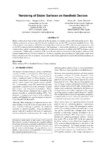Mostrar o rexistro simple do ítem
Rendering of Bézier Surfaces on Handheld Devices
| dc.contributor.author | Concheiro, Raquel | |
| dc.contributor.author | Amor, Margarita | |
| dc.contributor.author | Padrón, Emilio J. | |
| dc.contributor.author | Gil, Marisa | |
| dc.contributor.author | Martorell, Xavier | |
| dc.date.accessioned | 2017-06-22T17:12:39Z | |
| dc.date.available | 2017-06-22T17:12:39Z | |
| dc.date.issued | 2013 | |
| dc.identifier.citation | Raquel Concheiro, Margarita Amor, Emilio J. Padrón, Marisa Gil, Xavier Martorell, Rendering of Bézier Surfaces on Handheld Devices, Journal of WSCG 21(3), 2013, Pages 205-214, ISSN 1213-6972, http://hdl.handle.net/11025/6983 | es_ES |
| dc.identifier.issn | 1213-6972 | |
| dc.identifier.issn | 1213-6980 | |
| dc.identifier.issn | 1213-6964 | |
| dc.identifier.uri | http://hdl.handle.net/2183/19193 | |
| dc.description.abstract | [Abstract] Bézier surfaces have been widely employed in the designing of complex scenes with high-quality results. Nevertheless, parametric surfaces cannot be directly rendered in the current GPUs of modern handheld devices. This work proposes a non-adaptive method for tessellating Bézier surfaces on a GPU without primitive generator, such as the GPUs implemented in handled devices. Our technique is based on the utilization of a parametric map of virtual vertices, and its operation can be adapted to the hardware resources available in the GPU by tuning a series of parameters. Additionally, an analysis of the most relevant hardware constraints in the graphics hardware of the current handheld devices has been carried out. As those constraints prevent interactive high-quality results from being achieved, even with our proposal, we present an algorithmic approach focused on the real-time rendering on future handheld devices. | es_ES |
| dc.description.abstract | [Resumo] As superficies Bézier son frecuentemente empregadas no deseño de esceas complexas con bos resultados. Porén, as superficies paramétricas non poden ser diréctamente renderizadas nas actuais GPUs dos dispositivos móbiles modernos. Este traballo propón un método non-adaptativo para o telesado de superficies Béziar nunha GPU sen xerador de novas primitivas, o tipo de GPUs empregado polos dispositivos móbiles. A nosa técnica está baseada na utilización dun mapa paramétrico de vértices virtuais, e o seu funcionamento pode adaptarse aos diferentes recursos hardware existentes en distintas GPUs mediante o axuste dunha serie de parámetros. Ademais, tamén se levou a cabo unha análise das restriccións hardware máis relevantes nos dispositivos móbiles actuais. Dado que esas restriccións impiden acadar resultados interactivos de alta calidade, aínda coa nosa proposta, presentamos tamén unha aproximación algorítmica centrada no rendering en tempo real de futuros dispositivos móbiles. | es_ES |
| dc.description.sponsorship | Ministerio de Educación y Ciencia; MEC TIN 2010-16735 | es_ES |
| dc.description.sponsorship | Galicia. Consellería de Cultura, Educación e Ordenación Universitaria; CN2012/211 | es_ES |
| dc.description.sponsorship | Xunta de Galicia; ref. 2010/6 | |
| dc.language.iso | eng | es_ES |
| dc.publisher | Vaclav Skala - Union Agency | es_ES |
| dc.relation.uri | http://wscg.zcu.cz/JWSCG/J_WSCG_2013/!_2013_J_WSCG-3.pdf | es_ES |
| dc.rights | Atribución-NoComercial-CompartirIgual 3.0 España | es_ES |
| dc.rights.uri | http://creativecommons.org/licenses/by-sa/3.0/es/ | * |
| dc.subject | Bézier surfaces | es_ES |
| dc.subject | GPUs | es_ES |
| dc.subject | Handheld devices | es_ES |
| dc.subject | Tuning rendering | es_ES |
| dc.title | Rendering of Bézier Surfaces on Handheld Devices | es_ES |
| dc.type | info:eu-repo/semantics/article | es_ES |
| dc.rights.access | info:eu-repo/semantics/openAccess | es_ES |
| UDC.journalTitle | Journal of WSCG | es_ES |
| UDC.volume | 21 | es_ES |
| UDC.issue | 3 | es_ES |
| UDC.startPage | 205 | es_ES |
| UDC.endPage | 214 | es_ES |
Ficheiros no ítem
Este ítem aparece na(s) seguinte(s) colección(s)
-
GI-GAC - Artigos [190]






